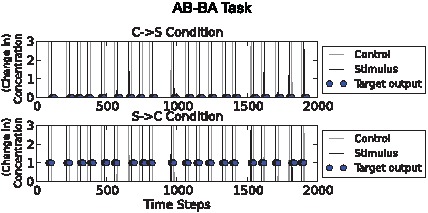Figure 4. AB-BA task illustration.

Above: “C→S” condition. Below: “S→C” condition. Stimulus (“S”) and control (“C”) pulses are shown as grey and black spikes respectively. Circles show target output values. This task spans a longer time period than the others, because it is noisier. In the C→S condition C pulses typically precede S pulses, whereas in the S→C condition, S pulses typically precede C pulses. The chemical network must produce a high output chemical concentration following the S pulse in the S→C condition but not in the C→S condition. The noise involves flipping of the order of S and C pulses so that S→C pulses sometimes occur in the “C→S” condition and vice versa. The noisiness can be controlled.
